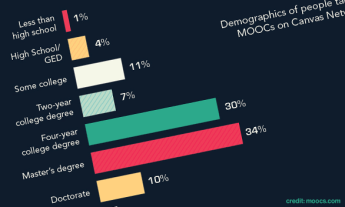“I sometimes look back at the TED Talk and I try to think of where we were at the time. We had four university partners, about a half a million students, 37 courses. Now we have more than six million students, more than 550 courses and 107 institutions that are working for us. And ‘MOOC’ is now a buzzword in many, many households.”
Daphne Koller is reminiscing. The cofounder of Coursera, one of the biggest for-profit MOOC ventures, spoke at TEDGlobal in 2012. A mere year and a half later and her fledgling organization has turned into a higher education behemoth. The company raised some $85 million to fuel its online mission, and as of January 17, 2014, Coursera boasted more than 21.5 million enrolments.
Its most popular class has 259,969 students, simultaneously studying Scott Plous’ Wesleyan University course in social psychology. 259,969! That’s a far cry from the university model of old, in which small groups of like-minded students gather for spirited discussion of the topics of the day.
For Koller, it’s also indicative of larger change that’s rolling through the world of higher education. “It’s pretty amazing how far we have come in terms of impact, reach and visibility,” she said in a recent phone call. “The other big surprise has been the extent to which we have transformed the conversation about higher ed, about where it’s going and the use of technology and instruction and so on and so forth. When we started, even at the time of the TED Talk, the whole notion of online education was perceived as one of those things that, yeah, ‘maybe the University of Phoenix and some of the community colleges dabble in it, but that’s not what we do at the top universities.’ And that conversation has definitely changed. The narrative is not if but when and how and to what extent will this completely transform the way we teach our students.”
It’s heady talk. And perhaps unsurprisingly, that has occasionally ruffled the feathers of educators and education insiders who have a different take on when, how and to what extent education might be transformed. Is there some inverse snobbery at play here? (“Who are these Stanford types to weigh into a problem that’s proven intransigent for decades?”) Very probably.
But the critics also have some data. For one thing, the dropout and failure rate of MOOCs is notably high; according to a survey by moocs.com, the average course completion rate in 2012 was a pretty lousy seven percent.
Koller? She brushes such criticism off as “a fairly drastic misconception.” “Of the people who sign up for a MOOC, on average half or more don’t even show up on the first day,” she says. “An analogy here is someone who is flipping through the course catalog of their local college and saying, ‘that one sounds interesting, so does that one,’ and they put a little ‘x’ next to it. And you know what? Then they don’t actually go to class.” Instead of being downcast about the sight-seers, she thinks we should rethink the way we’re interpreting the data.
For instance, how would we think about people buying The New York Times and then failing to read it from cover to cover? “Is the fact that someone ‘dropped out’ on page 13 a failure of the newspaper?” she asks. “Similarly, if you pick up Tom Friedman’s book The World Is Flat and then put it down after three chapters, is that a failure of the book or an indication that you got a lot of thinking from those chapters?”
The other thing that seems to enrage critics of Coursera: all that VC money, which naysayers seem to believe mean the company is destined to lure users in before staging a bait-and-switch to start charging them through the nose. Again, Koller will have no truck with this line of questioning. “We’re controlling what’s going on,” she says firmly. “We understand the higher ed ecosystem at this point better than most people, and I don’t think they [the VCs] claim to have a deep understanding of how your typical provost thinks. So we have not had any prescriptive guidance from them, and only some good suggestions, like, you know, we should really think seriously about how to penetrate into China, which we’ve actually done pretty effectively.”
For Koller herself, the most interesting thing about MOOCs is that they are emerging not as a substitute for college education but as a way to enable the idea of lifelong learning. “We need a way to integrate education much more deeply into the fabric of our lives in a lifelong way,” she says. “And that’s what we’re doing.”













